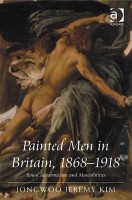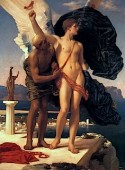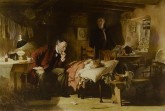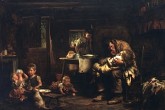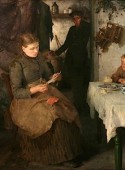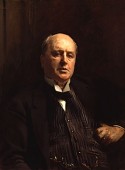The browser will either open the file, download it, or display a dialog.
Jongwoo Jeremy Kim,
Painted Men in Britain, 1868–1918: Royal Academicians and Masculinities.
Farnham, Surrey: Ashgate Publishing, 2012.
194 pp.; 66 b&w illustrations; 4 color illustrations; bibliography; index.
$99.95 (Hardcover)
ISBN 978-1-4094-0008-0
In E.M. Forster’s 1914 novel, Maurice, the eponymous protagonist visits his family doctor, Dr. Barry. Tormented and distraught, Maurice agitatedly disrobes. Standing nude before the good doctor, he tearfully admits, “I’m an unspeakable of the Oscar Wilde sort.” The physician replies, “Rubbish! Rubbish!” Dismissing even the possibility of Maurice’s homosexuality, the doctor frantically calls for some whiskey.
As Jongwoo Jeremy Kim explains in his new book, Painted Men in Britain, 1868–1918: Royal Academicians and Masculinities, it was the enigma posed by Maurice’s naked body that confused the doctor. Maurice was hale, hearty, even virile, all signs pointing to healthy heteronormative pursuits. Bewildered by this incongruity between robust body and sick mind, explicable by what could only be described as the “temptation of the devil,” Dr. Barry insists Maurice get dressed, to cover his exposed, muscular frame. As Kim states, “Denial and concealment were in order. What cannot be understood must not be seen: It must be left in the darkness” (161).
As Maurice’s puzzling body and transgressive masculine desires were covered up, so too the academic paintings discussed in Painted Men have long been “denied and concealed from the history of modernism, cast into invisibility of darkness,” a fact which Kim finds “troubling” (161). A welcome addition to many recent re-evaluations of British art of the late-nineteenth and early-twentieth centuries, Kim’s study focuses on the art of Frederic Leighton, Luke Fildes, Frank Holl, Hubert Herkomer, Henry Tuke, and John Singer Sargent.[1] The book was developed from “Royal Academicians and the Crisis of Masculinity in Modern England,” the author’s 2007 New York University Ph.D. dissertation.
Each of Kim’s four chapters is a case study in which he uses close readings of British paintings to examine the crisis that he describes as a fundamental attribute of modernism: the “destabilization of gender and sexuality” (9). Like his teacher, Linda Nochlin (to whom he playfully pays homage in his Introduction with the sub-heading, “Why Have There Been No Great British Artists?”), Kim is interested in expanding the established discourse of modernism to include British academic art, whose value he thinks has been regrettably overlooked. He advocates a “gendered and sexual approach” to the work of several frequently maligned and often ignored late nineteenth- and early twentieth-century British academic artists (9).[2] Painted Men is not a survey, nor an attempt to argue the merits of the academic versus the avant-garde. As Kim explains, “attempts to construct Britain’s own history of modernism have relied on indiscriminately elevating any loose brushstrokes, disjunctive modeling, and geometricization to the levels of signs of paradigm shifts, generating lists of ‘British Impressionists’ . . . and so forth to parallel French varieties (9).” He then points out that this merely repeats the same efforts of early feminist scholars who looked in vain for female Picassos, a strategy that never worked.
Instead, Kim scrutinizes these objects with an open mind and fresh perspective, which, he conjectures, may have something to do with his Korean background. Approaching the Western art historical canon from the outside, Kim finds these pictures rife with critical possibilities, unlike scholars in the past: “To me, the art of Royal Academicians such as Leighton, Sargent, and Tuke have always looked far from conventional because of their unconventional presentation of gender and sexuality” (8). Indeed, going against the grain of conventional sexual representation has always been an accepted tenet of modernism, and Kim is eager to demonstrate just how these objects not only meet, but also in many ways exceed such qualifications. Kim is especially interested in analyzing many of these artists’ treatment of the male body, in search of the visual deviations of masculinity that form the core of his project.
Of course, utilizing the implications of sexuality as a category of analysis in the history of art is hardly new—neither is using the homosexual perspective as a critical starting point.[3] Since the mid-1990’s, art historians have embraced what has come to be known as queer methodology, and have applied this lens to many and varied purposes. In the field of nineteenth-century British art history, scholars such as Michael Hatt, Andrew Kestner, Herbert Sussman, and Andrew Stephenson (whose work is cited in Kim’s acknowledgements as a “model to emulate”) paved the way for younger academics like Kim, who takes something of a broader approach to this method.[4] Largely abandoning traditional binaries such as masculine versus feminine or heterosexual versus homosexual, Kim finds that using such overly simplified denotations to read these paintings does not adequately reflect the complex contemporary sexual debates at hand. The homosocial, the polysexual, the instabilities of gender, and the painted signs of doubt, desire, subversion, and anxiety are, for Kim, better indicators of meaning. His purpose is not to “out” Sargent, for example, but instead to investigate Sargent’s “pictorial language of gender trouble”; Kim is looking for painted signs of sexual subversion (10). Like the title of the book rather wryly implies, the painted men—and also the men that painted the men—reveal cultural attitudes towards masculinity and, as Kim ultimately demonstrates, modernity.
In his first chapter, “Picturing Masculinities in the Orient: Frederic Leighton,” Kim focuses on the President of the Royal Academy, Frederic Leighton. Although not historically considered an Orientalist, Leighton did travel extensively, and this chapter examines the impact of two months he spent in Egypt in 1868. Using Leighton’s travel diary, Up the Nile at Phylae, Kim parses out key events and narratives that constitute his vision of the Orient, including flowery descriptions of sub-human monkey-women, effeminate degenerate sailors, and an oddly detailed and obsessive taxonomy of skin colors—hardly surprising looking at the striking contrast of flesh tones in works like Daedalus and Icarus (ca.1869, The Faringdon Collection, Buscot Park, Oxfordshire) (fig. 1). Kim’s thrust is to re-examine several of Leighton’s history paintings (some made long after his return), by locating the ways in which the artist inserted his “Orientalist fantasies of gender and sexual alterity into the otherwise traditional narratives of [the paintings’] heroes” (9).
Kim argues that, unlike the generally accepted examples of Orientalism in Leighton’s oeuvre, usually limited to a handful of landscapes and his famous Arab Hall, it is actually in his Greco-Roman mythological and biblical history paintings that the Orient plays a central role (such as the one depicted on the cover of the book, Hercules Wrestling with Death for the Body of Alcestis, cropped to showcase Hercules’ ample posterior). As the author explains, for Leighton “the Orient embodied a powerful Other that the artist cast as the various forms of his fantasies and anxieties about masculinity and desire” (13). It is precisely in these moments that Kim astutely locates Leighton’s ambivalence about the male body.
Kim’s writing is strongest when analyzing canvases such as Icarus, in which Leighton perplexingly cast Daedalus as a dark-skinned Near Eastern native, his complexion contrasted to his son’s pure white flesh (fig. 1). This dichotomy for Kim reveals “the painter’s urgent desire for an antidote for the Orient–a cure for Oriental assimilation and degeneracy” (19). Further, this unusual painting prompts gender confusion instigated by details such as the exaggeratedly sensual chest of Icarus–described by a contemporary critic as having the “soft rounded contour of a feminine breast”. The incongruous pairing of father and son also disrupts traditional patriarchal ideals, as the dark, infantilized father crouches next to his stunningly upright, feminized son. Clearly something is going on here–and the author ably draws out these contradistinctions for the reader.
Kim’s argument that Leighton’s pictures reveal pictorial transgressions related to gender anxieties is sustained through intriguing re-assessments of Leighton’s biblical subjects, but unravels slightly when used to address the artist’s understanding of familial structure, chiefly due to a bit of overwrought methodology. Addressing the later painting, “And the Sea Gave Up the Dead Which Were in It” (1891–92, Tate Britain), Kim depends on several compositional studies to develop his argument that Leighton’s figural groupings demonstrate his conception of the Oriental family. The reader, however, becomes mired in an overly complicated explanation, dependent on various figure numbers combined with “groups” designated by letters such as (A), (X), and (Y). To comprehend the analysis becomes an analytical chore (31–44).
In Chapter 2, “The Gentleman’s Body and Class Anxiety: Fildes, Holl, and Herkomer,” Kim reassesses the social realist paintings of three notable academicians. Kim’s opening analysis of Fildes’ The Doctor (1891, Tate Britain and The Widower (1876, Art Gallery of New South Wales) is insightful (figs. 2 and 3). This comparison yields one of the chapter’s central arguments, that in the work of these distinguished academicians there are visible mutations of the male body as their class status shifts. In this case, the impoverished widower reveals an unstable masculinity, as he clings to his child, physically hunched and distraught, a foil to the staid, middle-class doctor, set quite separate and detached from his patient. As Kim explains, given their compositional similarities (albeit laterally reversed), these pictures offer “two oppositional genders of the male sex.” He argues that “the doctor is masculine despite his fair complexion, neat attire, and shiny shoes, while the peasant is less so despite his boorish appearance and dirty boots”, due to his more feminine display of tangible affection (60).
Kim goes on to show that such pictorial transgressions actually “betray the way manhood was defined in [Fildes’] mind” (60). Turning to the artist’s biography to support this claim, Kim points out that like many painters in this period, Fildes desperately desired upward class mobility. Having built a custom artist’s mansion in fashionable Holland Park at great expense, Fildes eagerly participated in the celebrity-artist culture of the day. But the author argues that such extravagant efforts had an additional price tag in the tremendous anxiety that sudden artistic success was tenuous at best, and one could just as easily lose it all. Kim contends that painting a canvas like The Widower was for Fildes an exercise in confrontation, a careful examination of what he feared most, the level to which he must never allow himself to sink.
While this may be the case, Kim does not give much evidence to support his argument other than these pictorial clues, nor does he address the much larger context of this painting’s creation. In 1876 Fildes was vying for academy membership, and had only just established his academic reputation with his first great success, Applicants for Admission to the Casual Ward (Royal Holloway College), the smash-hit of the 1874 Summer Exhibition. Its forceful social message and dark-toned realism established Fildes as a leader of what came to be known as the social realist school that flourished in England during the 1870s. Fildes was, therefore, beginning to be known for painting canvases of the darker side of life. It is a bleak, melancholy kind of realism, painted on an epic scale, but the paintings proved to be extremely popular, and they sold well. The Widower, therefore, is not an eccentric painting in Fildes’ oeuvre, but rather is building upon an artistic project well underway. The suggestion that such paintings pictorially expose Fildes’ private fears could perhaps be cogent, but needs to be placed against the largest context of how such images operated in the cultural field to be convincing.
According to Kim, a further demonstration that these paintings reveal Fildes’ personal beliefs was the fact that the artist cast himself as the protagonist of The Doctor. By modeling the painting’s middle-class hero after himself, Fildes negates his own persistent fear of class-slippage. And indeed, there is ample contextual evidence to support the theory that the man is at least partially modeled after the artist. Kim conjectures that in exorcizing his fear of pecuniary failure on canvas, Fildes was attempting to “ward off the accompanying horror of humiliation and emasculation” (63). But again, such a claim needs to be supported with solid evidence, which Kim does not provide. Did Fildes ever write about these fears?[5] And how does Kim account for the fifteen-year time span between these two paintings? What did Fildes paint in-between?
Later in the chapter, Kim investigates absent middle-class patriarchs in the paintings of Frank Holl. In a series of gloomy pictures Holl negates the male body entirely by focusing on grieving widows, a choice that Kim argues likewise serves to exorcise class fears. These paintings emphasize “that what a bourgeois man lays claim to, be it his life, his property, or his class, can be taken away at any time and, should he think he has control over any of it, he is sadly mistaken” (65).[6] While the author makes an interesting observation about these paintings, he does not locate them within the larger narrative of social realism, or the British genre painting tradition, in which an iconography of widows was already established. Holl in particular was known for painting melancholy subjects; widows and graveyards became something of a specialty. And while Kim is right to pick up on the anxiety implicit in the depiction of a grieving widow, he ignores the cultural currency of such imagery, which was meant to arouse the feelings of viewers, inspire pity, and theoretically, social change. Kim focuses his analysis on the missing male body, but what about the very present widow?
Moving even a step further with the third artist of the chapter, Hubert Herkomer, Kim argues that the male body has not only disappeared entirely, but been replaced. The author examines a hand-carved pew made by the artist’s father in A Zither Evening with my Students in the Studio (1901, Kunsthalle, Hamburg), a painting that depicts Herkomer’s male students gathered at his studio for a musical evening. As Kim explains, “the bodiless and, therefore, phantom presence of Lorenz Herkomer is felt through the pew, as a ghost would require a medium to exert physical influence” (75). It is something of a stretch for this reader to be strongly convinced that the painting of a piece of furniture has much to do with class-based gender anxiety, but here Kim is again dealing with absences, an absent patriarch, absent male model, and absent artist (Herkomer places himself nearly outside the picture plane). Kim does offer a cogent examination of the class instabilities prevalent in artists’ studio paintings, using the autobiography of the Italian life-model Gaetano Valvona as evidence. Unfortunately, neither of Kim’s assessments of Holl or Herkomer is as compelling as the divining of bodily manifestations of unstable masculinity in the pictures of Fildes. Likewise, Kim fails to include portraits of the elite by these three academicians, which he mentions, but curiously abandons in the course of the chapter. As all three of these artists turned to society portraiture, forgoing the social realist idiom, it is curious that Kim does not mine such objects for their obvious relation to the issue at hand (never had more “painted men” been seen on the walls of the Royal Academy as in the last decades of the nineteenth century).
Of all the artists included in the book, Henry Scott Tuke, the subject of Kim’s third chapter, “The Utopia of Inverts”, was the most directly tied to the homosexual subculture. Tuke was associated with the Uranian poets and a frequent contributor to the magazine, The Artist. Edited by Charles Kains-Jackson, The Artist promoted same-sex, homoerotic discourse, primarily via the poetry of writers such as Paul Verlaine, Theodore Wraistlaw, and John Addington Symonds. Kim includes several examples of these poetic works, illustrating the frequently direct connections to Tuke’s paintings of young male bathers (such as the poem, “August Blue” by Alan Stanley, which was based on Tuke’s painting of the same name in 1893). The Uranian poets and Tuke sought to tie the love of the male form to nature, and further, to prove that homosexuality was in fact natural (as Symonds described it, an “inborn want”).
Kim’s analysis of Tuke’s “utopia” of sunbathing boys, handsome boaters, favorite male models, and nude bathers is agreeable, but even more persuasive is an analysis of what appears to be Tuke’s least sexually devious image, The Message (1890, Falmouth Art Gallery) (fig. 4). What at first seems to be merely an anecdotal Newlyn School genre painting (Kim provides an excellent comparison to the tradition of Victorian “letter pictures”), actually contains an even more illicit sign of deviant masculine promiscuity than a lascivious bather--the telegraph boy. Lurking in a shadowy doorway, Kim feels that the messenger “embodies boyhood itself as a threshold–a threshold of adulthood, masculinity, and sexual desire” (110). But perhaps more indicting than this shrewd compositional device was what the telegraph boy signified to contemporary viewers. Kim relays a fascinating connection to a highly publicized sex scandal in 1889-90 known as the Cleveland Street Affair which centered on young men posing as telegraph boys, but in fact working for a homosexual brothel. As Kim points out: “Considering the press coverage of the Cleveland Street Affair and its impact on English minds, when Tuke painted a telegraph boy in 1890, it was not an innocent subject matter” (110–11). Thus, the message of The Message was not nearly as straightforward as it appeared.
Kim’s final chapter addresses the work of John Singer Sargent. Titled “Masculine Death”, it covers a discrete selection of paintings that Kim believes display indicators of gender instability. Kim argues that Sargent pictorialized such concerns as three forms of death: death of the father (patriarchy), death of the dandy, and death of the soldier. Kim begins his chapter with the first of his masculine deaths, when a suffragette took a hatchet to Sargent’s portrait of Henry James (1913, National Portrait Gallery, London) on the opening day of the Royal Academy Summer Exhibition (fig. 5). Three slashes later the assailant was captured, the painting “killed”. The suffragette did not seem to know who the sitter was, nor the artist, but merely read the picture as a wealthy man, a symbol of the patriarchy, one of the men that refused to give women the vote.
Kim moves into a detailed analysis of the portrait to show that two sides of masculinity are actually present; the patriarch, yes, but also the deviant. The patriarch connoted by the watch chain, a masculine accessory that Kim luridly describes as having been ”painted thickly like a scab with coagulated blood–gold is appropriate for a patriarch’s gore–as if the trajectory of the snaking chain is how a suffragist would have cut James’s belly. Or does the chain hang like a spilled-out gut?” (127). Perhaps pushing the death metaphor a bit far here, Kim’s analysis of James as a deviant is likewise tenuous. While he does attempt to point to the disorderly lines of his waistcoat and a few strange smeared passages of paint, neither is a convincing sign of deviance. Far more troubling is Kim’s reliance on a contemporary observer’s notion of “the absence of ‘a certain something’” in the picture; that the artist was deliberately concealing the deviant nature of James’s character (129). Kim is implying that Sargent hid James’s true likeness, and in not showing it, proves an intimate kind of knowing, ergo deviance; such duality a “function of the closet in which James was most likely to have been” (129). While it is clearly not the author’s objective to make a claim either way about James’s homosexuality (or Sargent’s for that matter), his interpretation of the painting perplexingly seems to rely on it. And as Kim’s analysis of the painted signs of gender instabilities in the portrait is likewise rather weak, the reader is left unconvinced.
The final two sections of the chapter, involving Sargent’s portraits of dandies (such as Philip Sassoon and W. Graham Robertson), and his great war picture, Gassed (1918–21, The Imperial War Museum, London), similarly fail to meet the promise of the earlier chapters, but do provide interesting and oddly cohesive readings of what seem to be entirely disparate images.
While some of Kim’s analyses fall slightly short of the mark, what is successful throughout is that British academic paintings painted in a realistic idiom can be critically examined from new and challenging perspectives. Paintings that have long languished in museum storage or the art historical doldrums hold up to Kim’s rigorous analysis, and occasionally yield spectacular insights. Kim likens these ostracized pictures to Forster’s Maurice, whose body and desire were forced into the shadows: “Any modernist discourse that produces its meaning by controlling the darkness Maurice represents and uses that control as the basis of its historical authority must be opposed . . . I have sought to make this darkness more visible and legible” (161). In his goal of bringing these paintings into the light, Kim has succeeded.
Brittany M. Hudak
Ph.D. candidate
Joint Program, Case Western Reserve University and the Cleveland Museum of Art
brittany.hudak[at]case.edu
[1] For example, see the recent work of scholars such as Caroline Arscott, Tim Barringer, Elizabeth Prettejohn, Michael Hatt, Pamela Fletcher, Anne Helmreich, Anna Greutzner-Robins, Andrea Wolk Rager, Andrew Stephenson, and many, many others.
[2] One can hardly argue that John Singer Sargent has been ignored by art historians, but even when looking at well-known works, Kim takes a profoundly unconventional stance.
[3] Queer theory was the subject of a special issue of the Art Journal, “We’re Here: Gay and Lesbian Presence in Art and Art History,” co-edited by Flavia Rando and Jonathan Weinberg, 55, no. 4 (Winter 1996).
[4] See also the special issue of Visual Culture in Britain, “’Anxious Flirtations’: Homoeroticism, Art and Aestheticism in Late-Victorian Britain,” 8, no. 1 (Summer 2007), which includes contributions from leading scholars in this field of study, such as Jason Edwards, David Getsy, David Peters Corbett, Andrew Stephenson, and Michael Hatt.
[5] A voluminous collection of Fildes’ papers and letters is in the National Art Library, Victoria & Albert Museum, London.
[6] A point that would have been well made, but missed by the author, was that Holl did die rather unexpectedly in 1888 at the age of 43, leaving his wife and family fatherless, the sad realization of the fears Kim claims are expressed on canvas.


